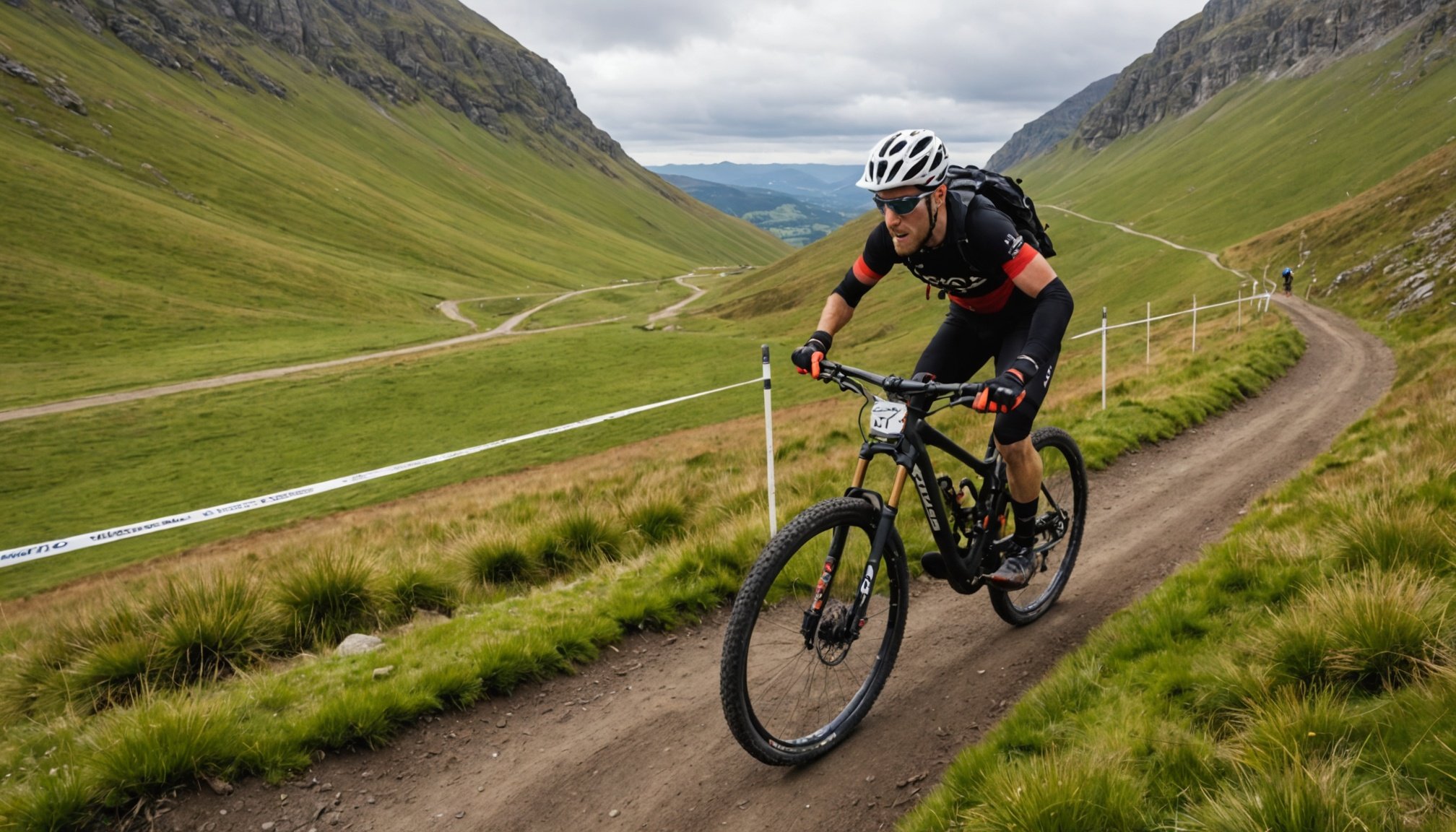Exploring Altitude’s Impact on Aerobic Performance: Essential Adaptation Strategies for UK Mountain Bikers
Understanding the Effects of Altitude on Aerobic Performance
When mountain bikers venture into high-altitude territories, they face a unique set of challenges that can significantly impact their aerobic performance. At high altitudes, the air pressure is lower, which means there is less oxygen available per breath compared to sea level. This reduction in oxygen availability, known as hypoxia, forces the body to adapt in various ways to maintain adequate oxygen delivery to the muscles.
Physiological Adaptations
At high altitudes, the body undergoes several physiological adaptations to compensate for the lower oxygen levels. One of the most notable adaptations is the increase in red blood cell production. The body produces more erythropoietin (EPO), a hormone that stimulates the production of red blood cells, which helps to carry more oxygen to the muscles. However, this adaptation takes time and is not immediate.
Also read : Unleashing Speed: Top Warm-Up Routines for UK Sprinters to Maximize Performance
| Adaptation | Description |
|
|-----------------------------------------------------------------------------|
| Increased Red Blood Cells | The body produces more red blood cells to carry more oxygen to the muscles. |
| Increased Myoglobin | Myoglobin in muscles increases to store more oxygen. |
| Increased Capillarization | More capillaries are formed to improve oxygen delivery to the muscles. |
| Increased Buffering Capacity | The body's buffering capacity increases to handle the increased acidity from high-intensity exercise. |
| Changes in Heart Rate and Blood Pressure | Heart rate and blood pressure may increase to compensate for the lower oxygen levels. |
Training at High Altitude: Benefits and Challenges
Training at high altitude can be a double-edged sword for mountain bikers. On one hand, it offers several benefits that can enhance performance, but on the other hand, it presents unique challenges that must be navigated carefully.
Benefits of High Altitude Training
High altitude training, also known as altitude training or hypoxic training, has been a staple for many elite athletes, including cyclists. Here are some of the key benefits:
Also read : Effective Tactics for UK Sports Clubs to Combat Online Bullying and Harassment
- Increased Red Blood Cell Count: As mentioned earlier, the body adapts by producing more red blood cells, which can improve oxygen delivery to the muscles even when returning to sea level.
- Improved Endurance Performance: Athletes who train at high altitude often see improvements in their endurance performance due to the body’s adaptations.
- Enhanced Power Output: High altitude training can also lead to improvements in power output, as the body becomes more efficient at utilizing the available oxygen.
Challenges of High Altitude Training
Despite the benefits, training at high altitude comes with several challenges:
- Reduced Training Intensity: Initially, athletes may find it difficult to maintain their usual training intensity due to the lower oxygen levels.
- Increased Fatigue: High altitude can lead to increased fatigue and reduced recovery times.
- Risk of Altitude Sickness: Athletes must be cautious of altitude sickness, which can range from mild symptoms like headaches and nausea to more severe conditions.
Practical Strategies for Adapting to High Altitude
For UK mountain bikers planning to train or compete at high altitudes, here are some practical strategies to help adapt and optimize performance:
Gradual Acclimatization
Gradual acclimatization is key when moving to high altitudes. Here’s a step-by-step approach:
- **Day 1-3**: Arrive at the high-altitude location and rest or engage in light exercise.
- **Day 4-7**: Gradually increase the intensity and duration of training.
- **Day 8 and beyond**: Continue to increase training load, but ensure adequate recovery time.
Monitoring Heart Rate and Power Output
Monitoring heart rate and power output can help athletes gauge their body’s adaptation to the high altitude.
- **Heart Rate Monitoring**: Use a heart rate monitor to track changes in heart rate during exercise. At high altitude, heart rate may be higher for the same intensity.
- **Power Output Monitoring**: Use a power meter to track changes in power output. Adjust training zones accordingly to avoid overtraining.
Nutrition and Hydration
Proper nutrition and hydration are crucial at high altitudes:
- **Hydration**: Drink more water than usual to compensate for the dry air.
- **Nutrition**: Focus on a balanced diet rich in iron to support red blood cell production.
- **Caffeine and Oral Supplements**: Caffeine can help improve performance, but be cautious of overuse. Oral supplements like beetroot juice may also help improve oxygen delivery.
Sleep and Recovery
Adequate sleep and recovery are vital for adaptation:
- **Sleep**: Ensure 7-9 hours of sleep per night to aid in recovery.
- **Recovery Techniques**: Use techniques like foam rolling, stretching, and compression garments to aid in recovery.
Real-World Examples and Anecdotes
Many elite cyclists have benefited from high altitude training. For example, professional cycling teams often conduct training camps in high-altitude locations like the Alps or Colorado.
Team Sky’s Altitude Training
Team Sky, now known as Ineos Grenadiers, has been a proponent of high altitude training. Their athletes have spent extensive periods training in locations like Tenerife and the Alps to prepare for major tours.
"Altitude training is a key part of our preparation for the big tours. It allows our riders to adapt to the lower oxygen levels and come back to sea level with improved endurance and power output," - Dave Brailsford, former Team Sky Principal.
Combining Altitude Training with Other Acclimation Techniques
Altitude training can be combined with other acclimation techniques to enhance performance further.
Heat Acclimation
Heat acclimation can be particularly beneficial for athletes who will be competing in hot and high-altitude conditions.
- **Heat Acclimation Protocol**:
- Spend 7-10 days in a hot environment (above 30°C) with high humidity.
- Gradually increase the intensity and duration of training over this period.
- Monitor body temperature, heart rate, and hydration levels closely.
University and Elite Research
Research from universities and elite sports programs has provided valuable insights into the effects of altitude on performance.
| Study | Findings |
|
|--------------------------------------------------------------------------|
| University of Colorado | Found that athletes who trained at high altitude showed significant improvements in endurance performance when returning to sea level. |
| Elite Cycling Teams | Studies on professional cycling teams have shown that high altitude training can improve power output and reduce the risk of injury. |
Training at high altitude is a complex but rewarding endeavor for mountain bikers. By understanding the physiological adaptations, practical strategies, and real-world examples, athletes can optimize their performance and gain a competitive edge.
Final Tips for UK Mountain Bikers
- Plan Ahead: Gradual acclimatization is key. Plan your training schedule carefully.
- Monitor Your Body: Keep a close eye on heart rate, power output, and overall health.
- Stay Hydrated and Nourished: Proper nutrition and hydration are essential.
- Combine with Other Techniques: Consider combining altitude training with heat acclimation for enhanced performance.
By following these strategies and staying informed, UK mountain bikers can navigate the challenges of high altitude and achieve their performance goals.











